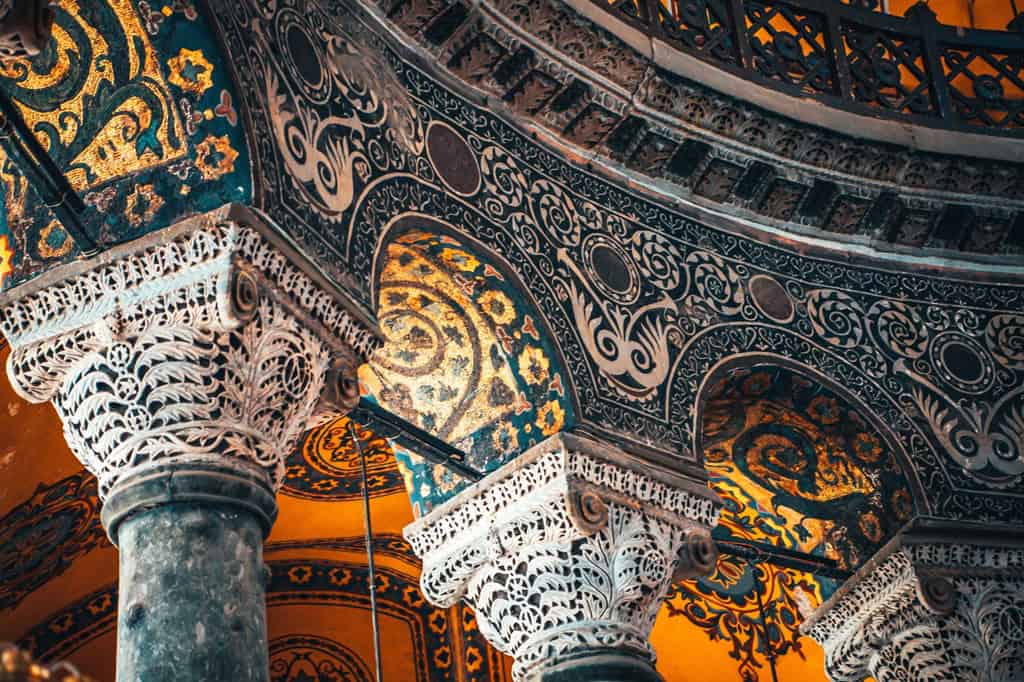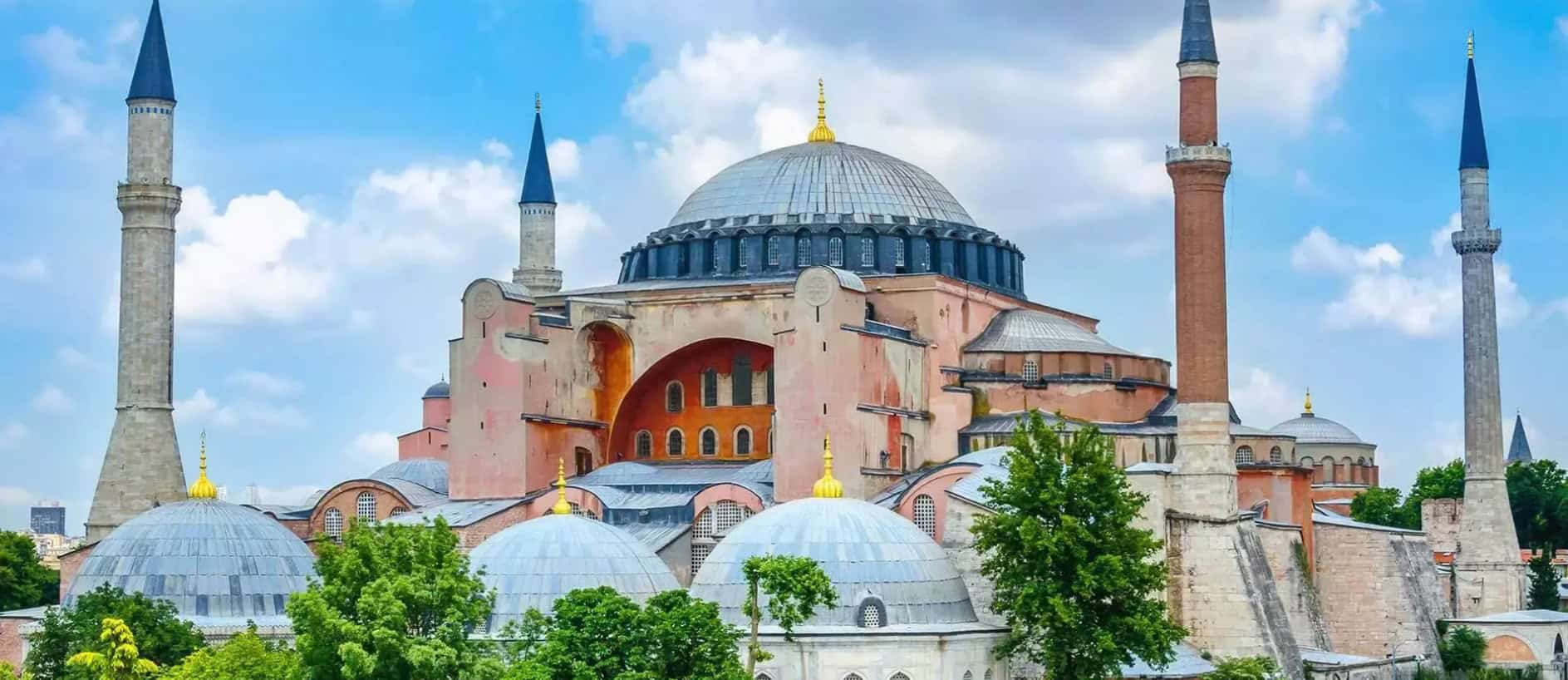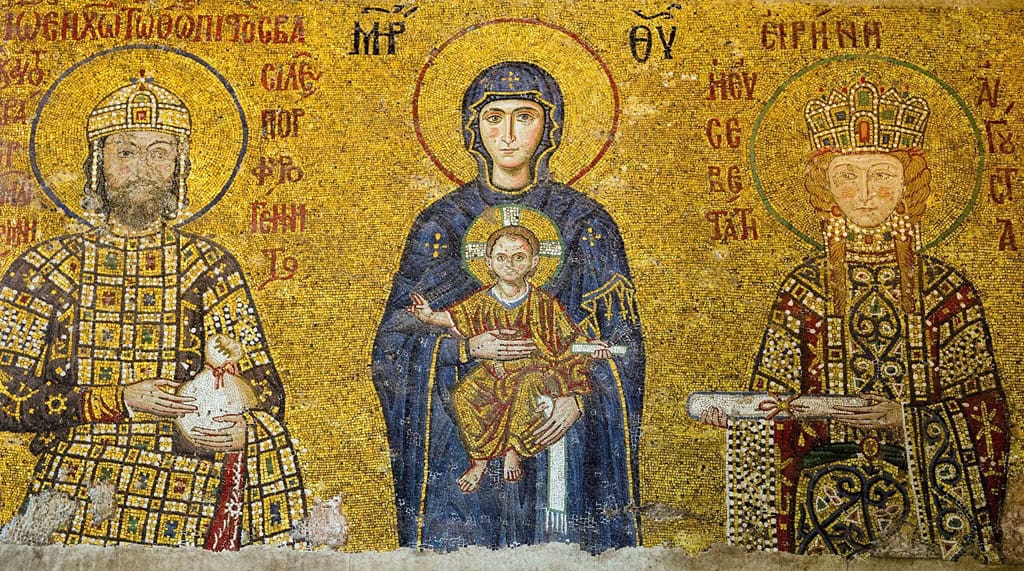Hagia Sophia: Entrance Fee, Opening Hours, How to Get There, and What to See
🌍 UNESCO | Hagia Sophia, or Ayasofya in Turkish, is a masterpiece of architectural history and one of the most visited landmarks in the world. Known as “Holy Wisdom” in Greek, Hagia Sophia was the world’s first cathedral and stands in the heart of Istanbul, Turkey. Built in 537 AD, this awe-inspiring structure has served as a cathedral, mosque, and museum, embodying the heritage of the Byzantium, Roman Empire, Ottoman Empire, and modern Turkey.

🚶♂️ Skip-the-Line Tickets
You will often encounter long ticket lines at Hagia Sophia, Topkapi Palace and Basilic Cistern. 🌟 Book your combo tickets here for the 3 attractions with the longest queues. Reserve now. Simply show the QR code at the entrance for quick access. (FYI official ticket price for Hagia Sophia is 25 €, for Topkapi Palace 45 €, for Basilica Cistern 30 € per person.)
Or if you prefer a private guide who also offers fast-track entry, fill out the form below.

REQUEST A LICENSED GUIDE ∇
Please fill the form to learn availability and cost
🎫 Tickets: Price, Waiting Times, and Guided Tours
- Ticket Price: As of Janauary 2025, the entrance fee is €25 (or equivalent in Turkish Lira) and can be paid by credit card or cash. This ticket will allow you to make a visit to the upper gallery where you can also see the praying section on the ground floor.
- Waiting Times: During peak periods—typically from April to November, on weekends, holidays, and cruise ship days—ticket lines can take up to 1-2 hours. In the winter, if there are no cruise ships in town and it is not a holiday period, the waiting time usually does not exceed 20 minutes.
- Topkapi Palace fast entry ticket + audio guide
- Guided tour for Topkapi Palace + Hagia Sophia + Basilic Cistern

💶Hagia Sophia entrance fee / price
⏰Opening days and hours
What Are the Opening Hours of Hagia Sophia Mosque? In 2025, the museum section (upper floor) of Hagia Sophia Mosque is open to both local and international tourists every day of the week from 09:00 to 19:00. Closed to tourist visits on Fridays between 12:30 and 14:30.

🚋 Where is Hagia Sophia, how to get there?
Address: Hagia Sophia (Ayasofya-i Kebir Cami-i Şerifi), Sultanahmet Square (Sultanahmet Meydanı), 34122 Fatih/İstanbul, Türkiye. Phone: +90.0212 522 17 50.
How to get there; Hagia Sophia is located on the historical peninsula of Istanbul in the Sultanahmet district. You can reach Hagia Sophia by the T1 tram line (Gülhane or Sultanahmet stops) or the Marmaray Metro Line (Sirkeci Station). It is a 10-minute walk from Gülhane, a 2-minute walk from Sultanahmet, and a 15-minute walk from Sirkeci Station.

A brief history of Hagia Sophia
Hagia Sophia, constructed three times on the same site, stands as the largest church built in Constantinople (now Istanbul) by the Eastern Roman Empire. The final iteration, renowned for its grandeur, is the one that exists today.
The First Church (360 AD): The first Hagia Sophia, known as Megale Ekklesia, was constructed in 360 AD under the reign of Emperor Constantine. This initial structure, with its wooden roof and basilical plan, was destroyed during a civil uprising in 404 AD, sparked by conflicts between Empress Eudoksia and Patriarch Ioannes Chrysostomos. Although no remnants of this first church survive, bricks marked as ‘Megale Ekklesia’ stored in the museum’s warehouse are believed to be from this original structure. A mosaic depicting Patriarch Chrysostomos can be seen on the northern tympanum wall of the current Hagia Sophia.

The Second Church (415 AD): The second church, commissioned by Emperor Theodosius II, was rebuilt in 415 AD. This building, known for its basilica plan with five naves, a wooden roof, and a grand entrance, was destroyed during the Nika Riots, a massive rebellion against Emperor Justinian on January 13, 532. Some remnants of this structure have endured, including marble steps, column bases, and reliefs featuring lamb figures symbolizing the apostles, as well as friezes from the building’s monumental gate (propylon).

The Present Hagia Sophia (537 AD): The current Hagia Sophia, a significant architectural marvel, was commissioned by Emperor Justinian I. The construction was overseen by two prominent architects of the time, Isidore of Miletus and Anthemius of Tralles. According to the historian Procopius, construction began on February 23, 532, and remarkably, the edifice was completed within just five years, opening on December 27, 537.
Historical records note that upon the inauguration of Hagia Sophia, Emperor Justinian entered the grand structure and is reputed to have exclaimed, “Thank God for giving me the opportunity to create such a place of worship.” He is also said to have declared, “Solomon, I have surpassed you,” in reference to the famed Temple of Solomon in Jerusalem. These statements reflect both his pride in achieving such an architectural feat and the building’s religious significance.
More information
Hagia Sophia is recognized as one of the oldest cathedrals and remained the world’s largest for nearly a millennium after its construction. Serving as a sacred site for centuries, its significance persisted even after Mehmet the Conqueror seized Constantinople. It functioned as a church for 916 years and a mosque for 482 years, excluding the period between 1204 and 1261 when the Crusaders converted it into a Catholic Cathedral during the Latin Empire. Mehmet the Conqueror, known for his respect for various religions and cultures, ensured the preservation of Hagia Sophia and other Byzantine structures. While he introduced a minaret and Islamic features, he also preserved the invaluable Byzantine mosaics and reinforced the structure to better withstand earthquakes.
In the 16th and 17th centuries, a mihrab, pulpit, and two lodges for the muezzin and the sultan (maksure) were added. Hagia Sophia was transformed into a complex during the Ottoman Period, with four minarets, a high school (madrasah), a secondary school, fountains, sundials, and a chamber of trustees built outside the building in different periods.
Hagia Sophia was converted into a museum in 1935 upon the order of Mustafa Kemal Atatürk (the founder of modern Turkey) and the decision of the Council of Ministers.
Interior decoration
Emperor Justinian I aspired to make Hagia Sophia a symbol of unparalleled magnificence and splendor. To achieve this, he commanded that the finest architectural elements be gathered from throughout his empire for its construction. The columns and marbles used in Hagia Sophia were sourced from ancient city ruins across Anatolia and Syria, including notable locations like Aspendos, Ephesus, Baalbek, and Tarsus. The structure’s white marbles were procured from the Island of Marmara (Prokonnesos), green porphyry from the island of Euboea, pink marbles from Afyon, and yellow marbles from North Africa.
The marble pieces, characterized by their colorful veins, were expertly sliced into symmetrical shapes for the wall coverings, enhancing the interior’s decorative richness. Additionally, green columns from the Temple of Artemis in Ephesus and eight porphyry columns sourced from Egypt were integrated into the naves and under the semi-domes, respectively. Hagia Sophia houses a total of 104 columns, distributed between 40 in the lower gallery and 64 in the upper gallery, each contributing to the grandeur and architectural brilliance of the edifice.

What to see inside Hagia Sophia
The Dome
The most significant innovation in the architecture of Hagia Sophia was its dimensions. The building was larger than usual for a church, with a dome that dominates the structure, notable for its size and height from the ground.

Hagia Sophia’s construction predominantly utilized marble, stone, and brick. To enhance the building’s earthquake resilience, specially crafted light and robust bricks made from the soil of Rhodes were employed in the dome’s construction, aimed at preventing its collapse during seismic events.
Mosaics and frescoes
Hagia Sophia is renowned for its exquisite mosaics, created during various periods, which contribute significantly to its aesthetic and historical value. Among these mosaics, the most significant and ancient examples are found in the narthex area. These early mosaics are particularly notable for their aniconic (non-figurative) designs, a characteristic feature of the early Byzantine period. The intricate details and artistry of these mosaics reflect the rich cultural and religious history of the edifice.

During the Byzantine era’s period of iconoclasm, which entailed the destruction of icons and other religious imagery, it is widely believed that all figurative mosaics within Hagia Sophia were removed. The mosaic situated on the apse ceiling, representing the first figurative mosaic created in Hagia Sophia after the end of this iconoclastic period in 843 AD, marks a significant shift in Byzantine art and religious policy.
Throughout Hagia Sophia, various figurative mosaics designed during different periods can be observed. These mosaics are especially prominent in the upper gallery, the tympanum wall, the narthex, the vestibule entrance, and the priests’ rooms. The diversity in styles and themes of these mosaics across different parts of the building reflects the rich historical and artistic evolution of Hagia Sophia over the centuries.

More to see in Hagia Sophia Museum
- The ruins of the second church
- The unique dome and its decorations
- Imperial Door, Orea Porta (Beautiful Door), and mosaics
- Serafim angels
- Sultan’s Lodge (Maksure)
- Pulpit / Muezzin’s Lodge
- Eight Islamic calligraphic panels
- Sweating / Wishing Column
- Upper Galleries and mosaics (closed for a period)
- Basket style Byzantine column headers
- “Deisis” composition showing John the Baptist and the Virgin Mary while praying to Jesus
- Gravestone of Enrico Dandolo, Duke of Venice, responsible for the devastating and terrifying attacks on Constantinople
- Heaven and Hell Gates
- Mosaics of Jesus The Pantocrator
- Mosaics depicting Saints Ignatius, Linus, and Ignatius Theophoros
- Mosaic showing Jesus consecrating Emperor Constantine IX Monomachus and his wife Zoe
- Two large cubes made of gooseberry (water marble) in Bergama
- The Viking inscription (closed for a period)
- The library built by Sultan Mahmud I in 1739
- Baptistry
- Sultan Tombs

